Atlantidae
Roger R. Seapy- Atlanta Lesueur, 1817
- Oxygyrus keraudreni Benson 1835
- Protatlanta souleyeti
Introduction
Atlantids are the most species-rich family of heteropods, containing over 60% of all species. They are small (< 1 cm), and their bodies can be retracted entirely into their shells and closed off by a chitinous operculum on the opercular lobe of the foot. The head has a pair of large tentacles anterior to the eyes. A large muscular sucker, located on the posteroventral margin of the swimming fin, is used to hold prey fast while feeding. Atlantids are found primarily between the surface and 200 m in tropical to subtropical waters. Many species undergo vertical migration from daytime depths into shallower waters at night.
Brief Diagnosis
A heteropod with:
- Microscopic size (to about 10 mm)
- Body retractable into shell.
Characteristics
- Shell
- Shell with dextral (right-hand) coiling and laterally flattened.
- Body retractable into shell; aperture closed by a chitinous operculum.
- Foot
- Sucker large and muscular to hold prey after capture.
- Opercular lobe and operculum present.
- Head
- Eyes well-developed, with a large spherical lens and a basal ribbon-like retina.
- Wall of eye partially to completely pigmented
- Tentacles large and may extend beyond contracted proboscis.
- Radula
- Rachidian tooth (central tooth in each tooth row) with one (Atlanta and Protatlanta) or three (Oxygyrus) short cusps.
Comments
The family Atlantidae includes three genera, two of which (Protatlanta and Oxygyrus) are monotypic. The genera can be distinguished by the following characters:
| Genus | Shell and keel compositon | Spiral portion of operculum |
|---|---|---|
| Atlanta | Calcareous shell and keel | Present |
| Protatlanta | Calcareous shell and conchiolin* keel | Present |
| Oxygyrus | Conchiolin shell and keel | Absent |
* Conchiolin, especially in fresh specimens, can be recognized by its extreme transparency.
Because of the presence of a shell into which their bodies can be retracted, sinking should be a major problem in the atlantids. As noted elsewhere, the carinariids and pterotracheids have enlarged, elongated bodies containing gelatinous tissues in which heavier sulfate ions are replaced by lighter chloride ions to achieve neutral buoyancy. Laboratory observations of Oxygyrus keraudreni by Land (1982) have shown that animals will alternately swim upwards for several seconds and then sink back down with their bodies extended from their shells for about 10 seconds. In-situ field observations of atlantids at night by Gilmer (in Lalli and Gilmer, 1989) indicated very different behavior than was exhibited during the day. Individuals were motionless, attached to long strands of mucus that appear to originate from the foot.

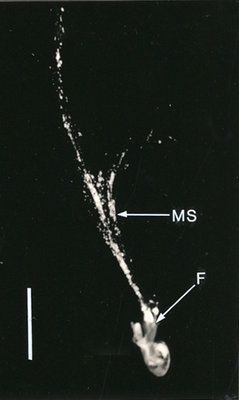
Figure. In-situ photograph of an unidentified atlantid attached to mucus strands (= MS), that extend about 45 mm above the animal. Note that the mucus appears to come from the foot (= F). Modified from Lalli and Gilmer (1989, fig. 11). © 1989 Ronald Gilmer
References
Lalli, C. M. and R. W. Gilmer. 1989. Pelagic snails. The biology of holoplanktonic gastropod snails. Stanford: Stanford University Press. 259 pp.
Land, M. F. 1982. Scanning eye movements in a heteropod mollusc. Journal of Experimental Biology 96: 427-430.
Richter, G. 1961. Die Radula der Atlantiden (Heteropoda, Prosobranchia) und ihre Bedeutung fur die Systematik und Evolution der Familie. Zeitschrift fur Morpholologie und Okologie der Tiere 50: 163-238.
Richter, G. and R. R. Seapy. 1999. Heteropoda, pp. 621-647. In: D. Boltovskoy (ed.), South Atlantic Zooplankton. Leiden: Backhuys Publishers.
Seapy, R. R. 1990. The pelagic family Atlantidae (Gastropoda: Heteropoda) from Hawaiian waters: a taxonomic survey. Malacologia 32: 107-130.
Spoel, S. van der. 1976. Pseudothecosomata, Gymnosomata and Heteropoda (Gastropoda). Utrecht: Bohn, Scheltema and Holkema. 484 pp.
Spoel, S. van der, L. Newman and K. W. Estep. 1997. Pelagic molluscs of the world. World Biodiversity Data Base CD-ROM Series. Amsterdam: Expert Center for Taxonomic Identification (ETI).
Title Illustrations

| Scientific Name | Atlanta peroni |
|---|---|
| Location | Hawaiian waters |
| Specimen Condition | Live Specimen |
| View | right side |
| Image Use |
 This media file is licensed under the Creative Commons Attribution-NonCommercial License - Version 3.0. This media file is licensed under the Creative Commons Attribution-NonCommercial License - Version 3.0.
|
| Copyright |
©

|
About This Page

California State University, Fullerton, California, USA
Correspondence regarding this page should be directed to Roger R. Seapy at
Page copyright © 2005
 Page: Tree of Life
Atlantidae .
Authored by
Roger R. Seapy.
The TEXT of this page is licensed under the
Creative Commons Attribution License - Version 3.0. Note that images and other media
featured on this page are each governed by their own license, and they may or may not be available
for reuse. Click on an image or a media link to access the media data window, which provides the
relevant licensing information. For the general terms and conditions of ToL material reuse and
redistribution, please see the Tree of Life Copyright
Policies.
Page: Tree of Life
Atlantidae .
Authored by
Roger R. Seapy.
The TEXT of this page is licensed under the
Creative Commons Attribution License - Version 3.0. Note that images and other media
featured on this page are each governed by their own license, and they may or may not be available
for reuse. Click on an image or a media link to access the media data window, which provides the
relevant licensing information. For the general terms and conditions of ToL material reuse and
redistribution, please see the Tree of Life Copyright
Policies.
- First online 16 February 2005
- Content changed 27 October 2008
Citing this page:
Seapy, Roger R. . 2008. Atlantidae . Version 27 October 2008 (under construction). http://tolweb.org/Atlantidae/28732/2008.10.27 in The Tree of Life Web Project, http://tolweb.org/




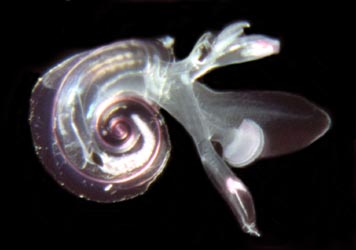
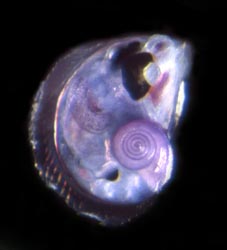
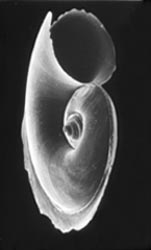


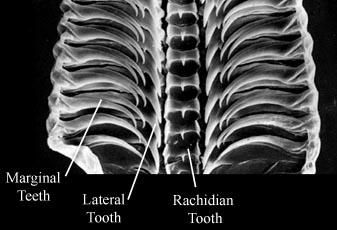



 Go to quick links
Go to quick search
Go to navigation for this section of the ToL site
Go to detailed links for the ToL site
Go to quick links
Go to quick search
Go to navigation for this section of the ToL site
Go to detailed links for the ToL site